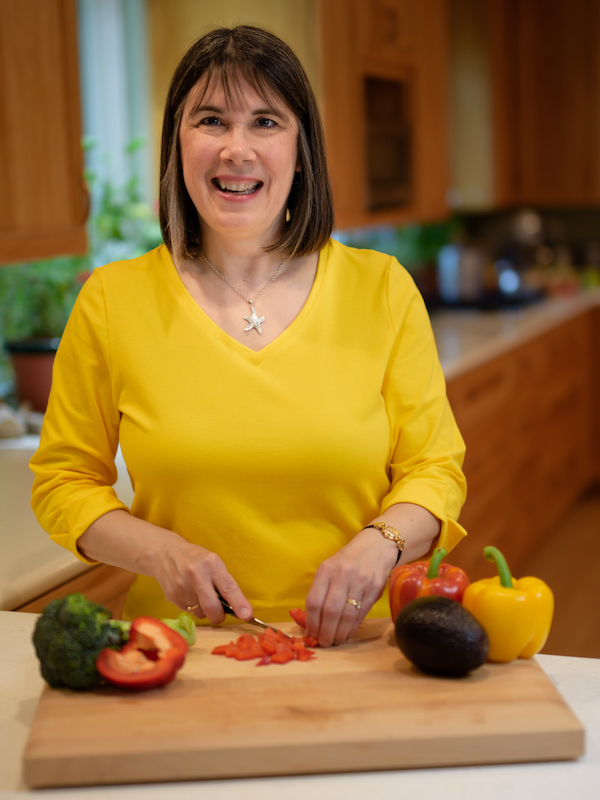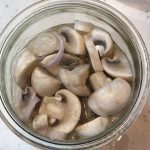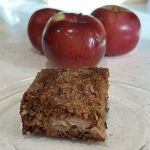

The Cooking Framework Quiz is available by clicking the button below.
Don’t miss an episode!
The button below will take you to Apple Podcasts to subscribe.
Or visit your favorite podcast provider to subscribe.
Thank you!
Here is the transcript of the episode:
Welcome to The Sensitive Kitchen, where home cooks are inspired to “Cook to Enable Those You Love to Flourish.” I’m Cindy Sullivan, registered dietitian, passionate nutrition educator, and accomplished home cook.
Whether you’re changing how you cook for food sensitivities, allergies, intolerances, or just trying to eat healthier on a budget, you’re in the right place. Most episodes, I will share favorite recipes as well as modification, tips and nutrition benefits. Occasionally I’ll have a guest or special episode like modifying holiday favorites. My favorite foods? They’re raspberries and homemade chocolate chip cookies. My latest cooking project was long fermented sourdough bread.
Welcome, welcome, happy spring! This week, I have an important announcement about The Sensitive Kitchen podcast. In the very near future. I will be moving from a weekly to a twice a month format. I knew when I started the podcast that my long-term goal was to produce two episodes a month, but to get started, I began weekly, but I’m finding that both blog posts – one for the recipe, with all the pictures and one for the podcast, with the transcript and resources, I am not having time for two important activities.
One is marketing the podcast so that people find it. And the second is my brand new membership called The Kitchen Table. I’m planning to launch it the spring, or I did plan to launch it this spring, but right now I’m planning on an August 20th launch. So over the next couple of months, while I make this transition, The Sensitive Kitchen podcast will be a little more than every other week.
For example, the next step is actually just next week. It’s for the amazing Summer Tortellini Salad that uses the homemade marinated sun dried tomatoes that we’re talking about today. And my wonderful student, Rebecca, will be back with another recipe.
So as I continue planning for the show. I’d love to hear your feedback. What would you like more of and what would you like to see? TodayI want to thank Olivia and Tiffany for your feedback.
This week, we’re going to talk about a favorite condiment, Homemade Marinated, Sun Dried Tomatoes, and two salad dressings that can be made from the vinegar that the sun dried tomatoes are soaked in.
I began making these marinated sun dried tomatoes for Summer Tortellini Salad about 25 years ago, but we quickly discovered that the leftovers were wonderful on pizza or on bread for topping crostini or bruschetta. They’re a great addition to omelets sandwiches or chicken surprise, which is what he used to call leftover chicken in a skillet with flavorful additions, these tomatoes, capers, marinated artichoke hearts, sweet peppers, mushrooms, whatever I happen to have.
My mouth is watering just thinking about these Marinated Sun Dried Tomatoes! Plus they keep well in your refrigerator and you can make a yummy salad dressing with vinegar – truly waste, not want not cooking!
So let’s talk about these Homemade Marinated Sun Dried Tomatoes. Now I do use sun dried tomatoes that I buy at the grocery store. I use the ones without sulfites, as my husband is sensitive to sulfites. So I get ones that are darker in color.
For ingredients – as well as the sun dried tomatoes, garlic, ricevinegar, or you can use another mild vinegar like white wine vinegar, some kind of oil – avocado, olive canola, – dried herbs, such as oregano, basil, marjoram, thyme and Parmesan cheese, which you can omit if you’re dairy free.
Now let’s talk a little bit about these ingredients, and possible substitutions. The only top allergen that’s contained in these tomatoes is Parmesan cheese. Omit it if you’re dairy allergic, however, if you’re lactose intolerant, you might be okay. Parmesan cheese is an aged cheese, so it is low lactose. Plus only two tablespoons are used in the entire recipe.
I use a pre-grated one. I actually use Kraft in the green container to save money. Plus I want the cheese to be in smaller pieces. It probably would be great made with a good Parmesan put through a rasp grater, but you’d have to use a little bit more as it’s fluffy that way as well.
I mentioned we do use sun dried tomatoes without sulfites. These tomatoes turn a very dark red color, and they’re not as soft as those with added sulfites, but since you’re going to soaking the tomatoes in vinegar, they’ll soften just fine. I do have a hard time finding them without sulfites in my area. Only Whole Foods carries them and they’re sometimes not available. I buy them in their 365 brand.
Now let’s talk a little bit about oil. Although I have used both olive and avocado oil in this recipe, I actually prefer canola oil because it stays liquid it refrigerator temperature, and this recipe is stored and keeps well in the refrigerator. However, if you choose to use olive or avocado oil, you’ll just need to let the tomatoes come to room temperature for the oil to turn back to liquid. Now, this obviously is not an issue of you’re putting the tomatoes on pizza or another warm dish as the heat will sort of melt the oil.
In terms of herbs. if you don’t have some of the herbs that are called for or if you prefer other herbs, just use what you have. This is a very flexible recipe in terms of flavorings.
Capers are also an interesting addition to this recipe. I would not purchase them just for this recipe, but as I usually have a partially open jar in the refrigerator, I sometimes add a tablespoon or two to this recipe.
Let’s talk a little bit about nutrition. Sun dried tomatoes are rich in vitamins, minerals and antioxidants. They have a particularly high concentration of lycopene, a powerful antioxidant. We talked about lycopene in episode 006, where we talked about fermented ketchup, but let me refresh your memory and give you a couple of additional reasons to eat sun dried tomatoes quoted from both web MD and SFgate healthy eating section.
There continues to be interest in lycopene’s benefits as an antioxidant. In addition to reducing free radicals all over your body, some early research shows that it might help protect your skin from the sun (awesome for summertime!) and age-related macular degeneration. Other studies show that lycopene may lower the risk of certain cancers, including a esphogeal and pancreatic cancer. And obviously more research is needed to better understand all these potential benefits,
But when it comes to getting the biggest lycopene bang for your buck, the absolute best option is sun dried tomatoes. This is due to bioavailability. Bioavailability is the amount of a substance that can enter your circulation and have an active effect. Sun dried tomatoes have higher bioavailability of lycopene than fresh or even canned tomatoes in terms of antioxidants.
When you think of tomatoes, you want to think of lycopene. But in addition to lycopene, sun dried tomatoes are also good sources of lutein and zeaxanthin. These other carotinoids – like beta carotene – in the same family – these other carotinoids that help your body fight free radicals that are especially damaging to your eyes.
Now, when we discussion nutrition benefits, you have to remember that most of the time nutrition information is given per hundred grams, which is about three and a half ounces. Well, that’s the entire package of the sun dried tomatoes. And because we’re using them as a condiment, you’re not eating a cup of them at a time, you’ll get smaller amounts of nutrients.
If you were however, to eat a hundred grams of sun dried tomatoes, you would get more than 40% of your daily recommended intake of fiber, both soluble, – soluble in water and insoluble. Primarily in tomatoes, it’s insoluble fiber. And that may help with constipation. If you eat a lot of sun dried tomatoes, but remember to drink water too.
Sun Dried tomatoes are also good sources of vitamin C, vitamin K vitamin a the B vitamins, niacin, thiamin, riboflavin, and a variety of minerals, including manganese, magnesium, phosphorus, iron, potassium, and copper.
Now, in terms of calories, sun dried tomatoes are more calorically dense than regular tomatoes because the water has been taken out. But in addition, when I analyze this recipe for nutrients, I want to make you aware that the nutrition calculator assumes that all of the oil that’s added to the recipe is being eaten. I find that I usually have some oil leftover to put in the vinegar to save for making salad dressing. In other words, we don’t eat all the oil.
So how do you make homemade marinated sun dried tomatoes? First of all, cut your tomato into pieces. Why do I bother to do this? Because I want tomato on every bite and I don’t want only tomato and to get a whole mouth full of tomato is a little overwhelming.
So cut your tomato into pieces. And this is the most time-consuming part of this recipe. I cut each tomato into half lengthwise and then each half into three or four pieces, depending on the size of the tomato. I use kitchen shears, but a knife would do as well. I cut the tomatoes as I mentioned, because I want them in small bite size pieces, but I also want other things in the same bite. So when they make the summer tortellini salad, I want a piece of marinated sun dried tomato, some tortellini, and a cashew, all in the same bite. Yum!
Put your cut tomatoes into a glass jar. I like to use my 19 ounce Weck jars for this. You don’t want a flat container because the tomatoes are all spread out and it’s hard to get vinegar on all the tomatoes evenly that way. You want the tomatoes to be stacked up.
Pour about three quarters, a cup of rice vinegar, or white wine vinegar and let stand for about an hour. Push the tomatoes down so they’re submerged in the vinegar and stir a couple of times during the hour that they’re soaking.
While your tomatoes are soaking, peel and slice your garlic. Remember to let your garlic sit about 10 minutes after slicing and before adding to the tomatoes to allow the alicin to develop. Listened to episode 003 for more on alicin.
At the end of the hour, drain the vinegar and save it. You’re going to use this vinegar to make the dressing we’re going to talk about in just a few minutes. Add all the other ingredients to the glass jar, stir well, cover, and store it in the refrigerator overnight.
They keep for at least a couple of weeks in the refrigerator, if you can keep them around that long. Next week, I will discuss my favorite way to use them, Summer Tortellini Salad. It’s a favorite in my house and among friends. I bring it to bridal showers, picnics, cookouts, potlucks, and it meets with rave reviews.
As I mentioned, I have made these marinated sun dried tomatoes for years and years. After soaking the tomatoes and rice vinegar. I always just threw it away. One day I had a brainstorm – I’m throwing away this highly flavored vinegar. Why not use it to make salad dressing?
The salad dressing is wonderful. Plus the vinegar stores well in my refrigerator for when I’m ready to make the salad dressing.
The second version of this dressing came about because we went on vacation with ripe tomatoes sitting on our counter. They were thrown into the refrigerator and we left. Upon our return, I had to figure out what to do with a couple of mushy tomatoes. In the midst of making sun dried tomato dressing, the mushy tomatoes caught my eye. What if I threw them into the blender with the dressing? I also added a couple of tablespoons of Parmesan and a wonderful variation was born.
It also has a vibrant orange color which isappealing. I use the sun dried tomatoes without sulfites that are dark in color, as I already mentioned. And the vinegar is very dark in color, but when you add everything for the dressing, it turns out actually to be a fairly light color, unless you’re making the fresh tomato variation and then it’s vibrant orange.
So what ingredients do you need to make the salad dressing? Sun dried tomato vinegar, rice, or white wine vinegar, Dijon mustard, salt, maple syrup, oil, and optionally, some mayonnaise.
Now I have used the leftover vinegar as the only vinegar in this dressing, but we found it too strong. I now use half marinated sun dried tomato vinegar, and half rice vinegar. You could use a white wine vinegar or any other mild vinegar. If you still find that too strong, use a quarter of the sun dried tomato vinegar and three quarters, mild vinegar.
I also do not recommend skipping the maple syrup in this dressing. It cuts the vinegar just enough without making the dressing too sweet. The last time I made it, I cut out the maple syrup and it was amazing how much better the dressing tasted with the maple syrup added.
And frankly, I don’t measure much of anything in this recipe. I just eyeball it. But I did measure for you and as always the recipe and all the directions are at foodsensitivitykitchen.com/episode028. Now the Dijon mustard acts as an emulsifier in this dressing. If you want a creamier dressing that does not separate as easily, add two tablespoons of mayonnaise to the Dijon and blend.
Use whatever liquid oil you desire. Just remember that if you use an avocado or an olive oil, you’ll have to let it come to room temperature before you use it after storing it refrigerator because the oil will congeal at refrigerator temperature.
I usually make this dressing in my blender because it is just so easy. But for the regular dressing, you can do it in a bowl with a whisk. If you choose this method, I have a tip to share with you. Place the Dijon mustard in a small bowl, add about a teaspoon or so of the vinegar that you’re going to add to the dressing. Stir in the vinegar, add another teaspoon of vinegar and stir well. Keep adding a teaspoon of vinegar at a time until the mustard is liquid-y. This way, the mustard doesn’t clump or stay in clumps when you try to make your dressing.
If you want to make the dressing with whole tomatoes and Parmesan, you need a blender. As I mentioned, this is a great way to use up tomatoes that are too ripe or somehow ended up in your refrigerator and you need to use them. The ingredients are the same with the addition of either two small or one large tomato and two tablespoons of Parmesan cheese. In this version, I would try it without the maple syrup first. And then just add it if you think the dressing is too sharp.
I have made a very simple vinegarette here, but feel free to add herbs or spices to your family’s tastes. If you’re used to purchasing purchasing salad dressing, you will be amazed at how much money you save, and you’ll use up the vinegar that you were going to throw away.
Anyway, in terms of allergies, there are no top nine allergens in this dressing, but if you are sensitive to sulfites, be careful. Use sun dried tomatoes without sulfites. I can only find them as I mentioned at Whole Foods. However, if you’re going to make the dressing and add the tomatoes, leave out the Parmesan, cheese of your dairy allergic.
So three recipes for you today. Two salad dressings, and a homemade marinated sun dried tomato. Thanks so much for listening. I’d love it if you’d leave me a review and share the podcast with a friend.
Remember you can find the recipes at foodsensitivitykitchen.com/episode028. Or you can email me at [email protected]. Keep Cooking to Enable Those You Love to Flourish! Have a great day. Bye-bye.
Resources
Nourish by WebMD Health Benefits of. Sun Dried Tomatoes https://www.webmd.com/diet/health-benefits-sun-dried-tomatoes#1
What Are the Health Benefits of Eating Sun Dried Tomatoes? By Sandi Busch Updated November 21, 2018
https://healthyeating.sfgate.com/health-benefits-bok-choy-1551.html




